Solved Examples: Triangles | Quantitative Aptitude for SSC CGL PDF Download
Question 1: In a
a) 12 cm
b) 10 cm
c) 16 cm
d) 20 cm
 View Answer
View Answer 
Answer (A)
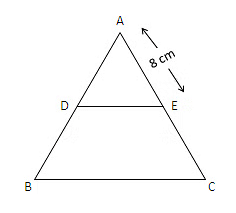

Here,  and AE = 8 cm
and AE = 8 cm

Here, AC = AE+EC = 4+8 = 12 cm
Question 2: In a
a) 26 cm
b) 24 cm
c) 28 cm
d) 32 cm
 View Answer
View Answer 
Answer (B)
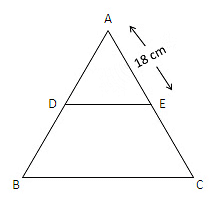
Given, DE is parallel to BC.
Then 
Here,
AE= 18 cm 
⇒ EC = 6 cm
AC = AE+EC = 6+18 = 24 cm
Question 3: In a
a) 10 cm
b) 14 cm
c) 12 cm
d) 9 cm
 View Answer
View Answer 
Answer (B)
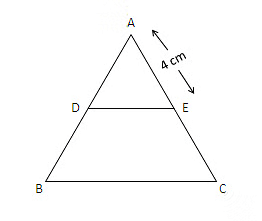
Given, DE is parallel to BC.
Then, 
Here,
AE= 4 cm 
⇒ EC = 10 cm
AC = AE+EC = 4+10 = 14 cm
Question 4: The coordinates of the vertices of a right-angled triangle are A (6, 2), B(8, 0) and C (2, -2). The coordinates of the orthocentre of triangle PQR are
a) (2, -2)
b) (2, 1)
c) (6, 2)
d) (8, 0)
 View Answer
View Answer 
Answer (C)
Given that the coordinates of a right-angled triangle are A (6, 2), B(8, 0) and C (2, -2).
We know that the distance between two points(a, b) &(c, d) is
Therefore, angle A is right angled.
Since it is a right angled triangle, the 2 sides adjacent to the right angle will be altitudes. The third altitude must meet at the vertex at which these 2 sides meet.
Hence, the vertex that contains the right angle is the orthocentre. From the points given, we can clearly see that (6, 2) is the orthocentre. Option C is the right answer.
Question 5: find the area of an equilateral triangle if the height of the triangle is 24 cm.
a)
b) 
c)
d)
 View Answer
View Answer 
Answer (A)
Given,
AD = 24 cm and ABC is an equilateral triangle
In an equilateral triangle all the angles are equal to 60°
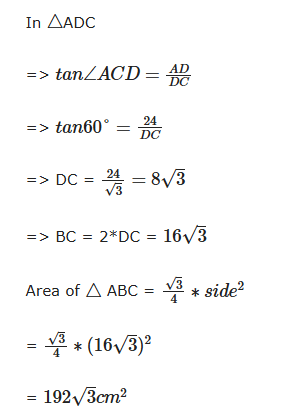
Question 6: Three sides of a triangular meadow are of length 28 m, 45 m and 53 m long respectively. Find the cost of sowing seeds(in rupees per sq.m) in the meadow at the rate of 12 rupees per sq.m.
a) 7560
b) 6860
c) 7960
d) 7860
 View Answer
View Answer 
Answer (A)
Given the sides of triangle are 28 m, 45 m and 53 m
Since,
=> The given sides are of right angled triangle as,
where a, b, c are the sides of the triangle
.=> Area of triangular field 
=> Cost of sowing seeds = 
Question 7: In a triangle PQR, internal angular bisectors of
a)
b)
c)
d)
 View Answer
View Answer 
Answer (C)
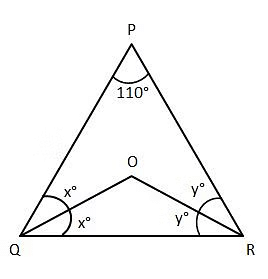

Sum of angles in a triangle=180
2x+2y+110=180
2x+2y=70
x+y=35
Similarly in the triangle QOR we have


Question 8: In a triangle XYZ, XA is the angle bisector onto YZ. If the semiperimeter of the triangle is 12 and XY=12 ,YZ=6 then what is the ratio of YA:AZ ?
a) 2:3
b) 2:1
c) 1:2
d) 3:2
 View Answer
View Answer 
Answer (B)
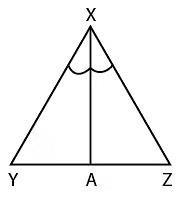
In triangle XYZ we have s=12
(x+y+z)/2 =12
x+y+z=24
12+6+y=24
y=6
Angle bisector divides the opposite side in the ratio of other sides i.e
XY/XZ=YA/AZ
YA/AZ=12/6
YA/AZ=2:1
Question 9: In a triangle ABC, AX is the angle bisector onto BC. If the semiperimeter of the triangle is 9 and AB=4 ,BC=6 then what is the ratio of BX:XC ?
a) 2:3
b) 2:1
c) 1:2
d) 3:2
 View Answer
View Answer 
Answer (C)
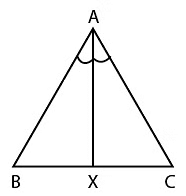
In triangle ABC we have s=9
(a+b+c)/2 =9
a+b+c=18
4+6+b=18
b=8
Angle bisector divides the opposite side in the ratio of other sides i.e
AB/AC=BX/XC
BX/XC=4/8
BX/XC=1:2
Question 10: In an equilateral triangle,if h-R=15 cm where h=height of the triangle and R=circumradius then what is the area of the triangle ?
a) 
b) 
c) 
d) 
 View Answer
View Answer 
Answer (D)
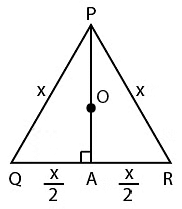
In an equilateral triangle,all the points such as orthocentre,centroid,circumcenter coincide.
Let the triangle be PQR and the circumcentre be O. let median intersect QR at A
Centroid divides median in the ratio 2:1.PA=h,OA=R
OA=15 cm
Therefore (PO:OA)=2:1
PO:15=2:1
PO=30
PA=PO+OP
PA=30+15
PA=45
PA is also the altitude using it side of the triangle can be calculated.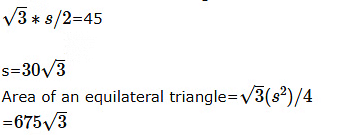
|
317 videos|290 docs|185 tests
|
FAQs on Solved Examples: Triangles - Quantitative Aptitude for SSC CGL
| 1. What are the different types of triangles based on their angles? |  |
| 2. How do you calculate the area of a triangle? |  |
| 3. What is the Pythagorean theorem and how is it used in triangles? |  |
| 4. How can you determine if three given side lengths form a triangle? |  |
| 5. How do you find the missing angle in a triangle? |  |
















